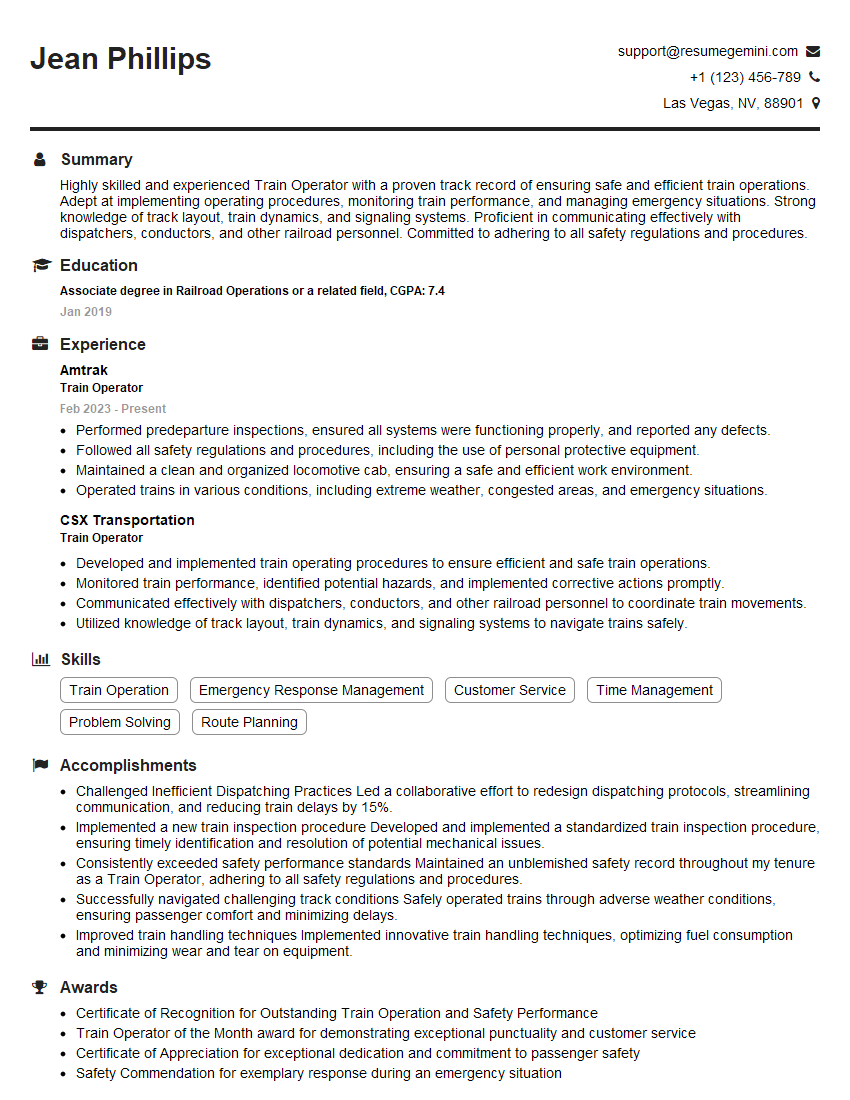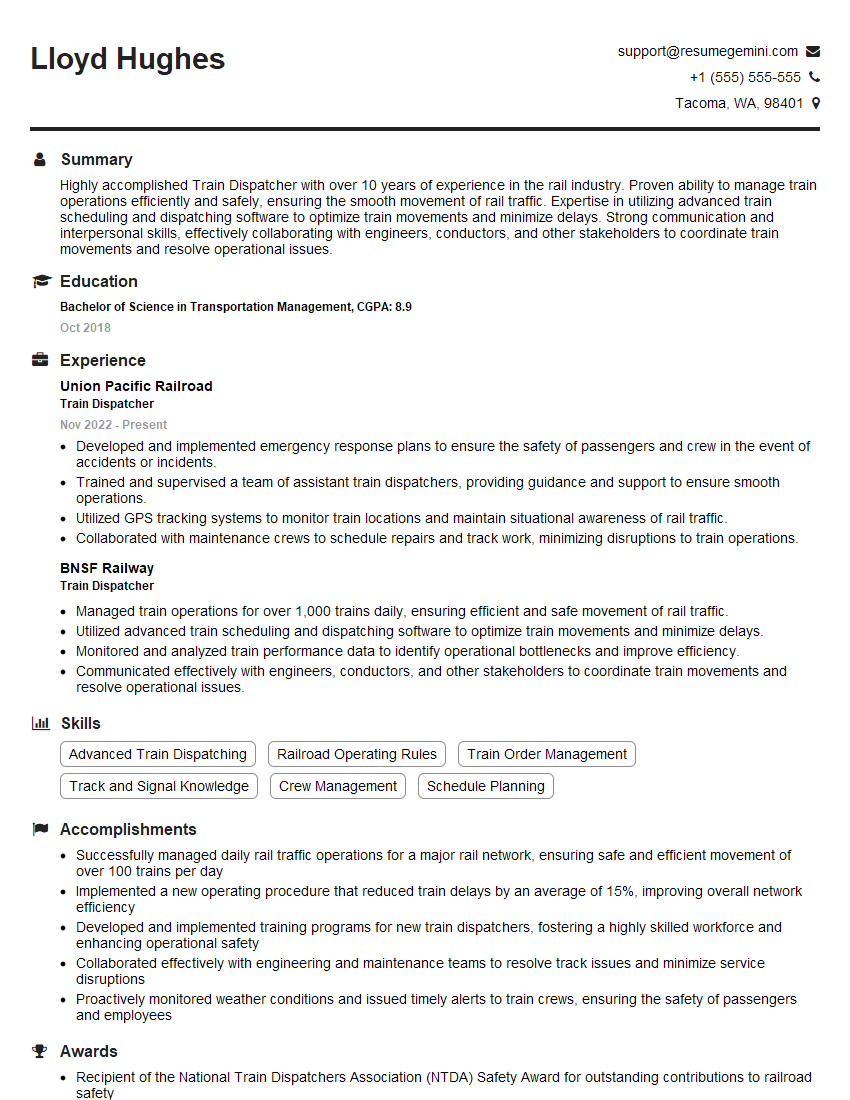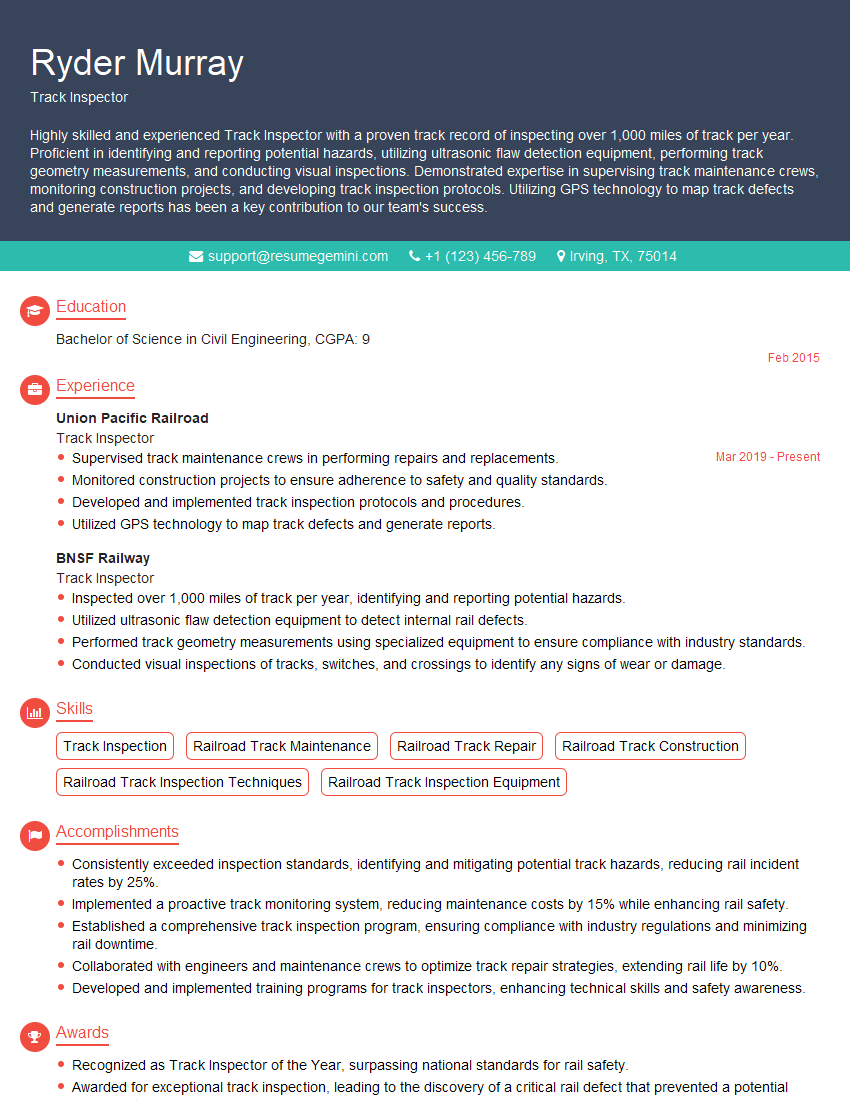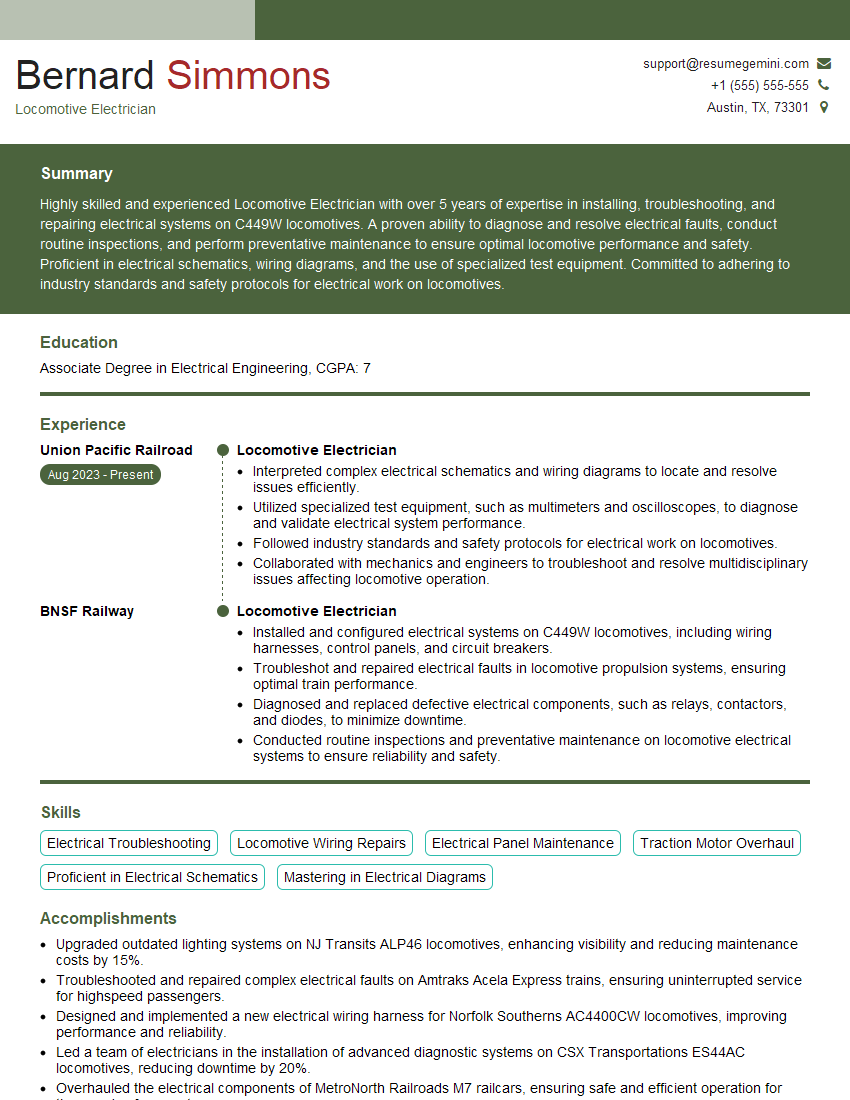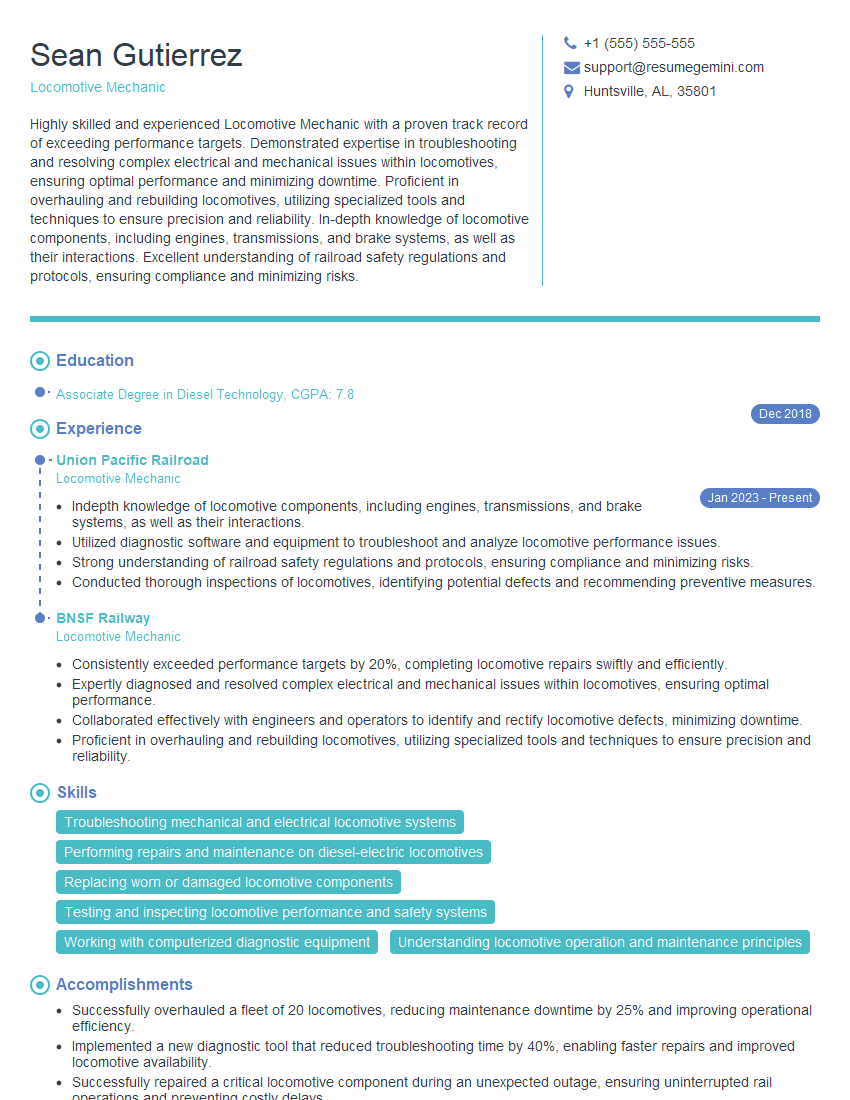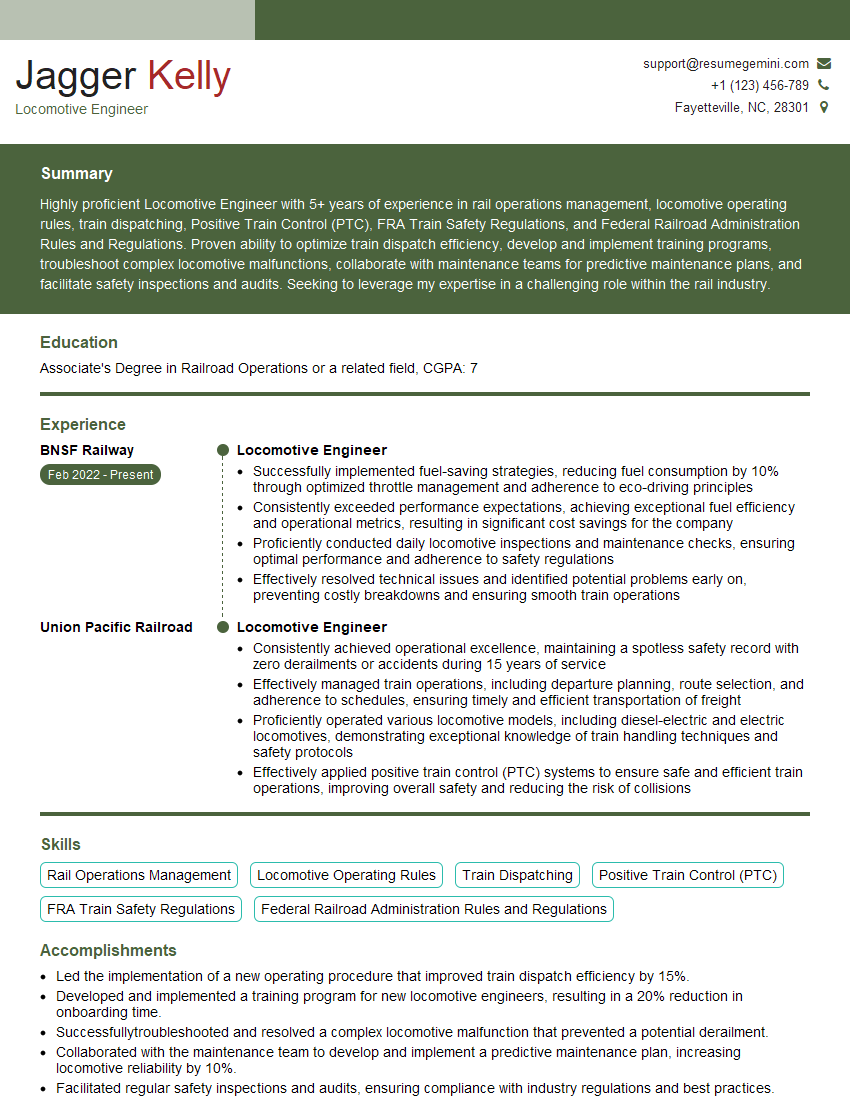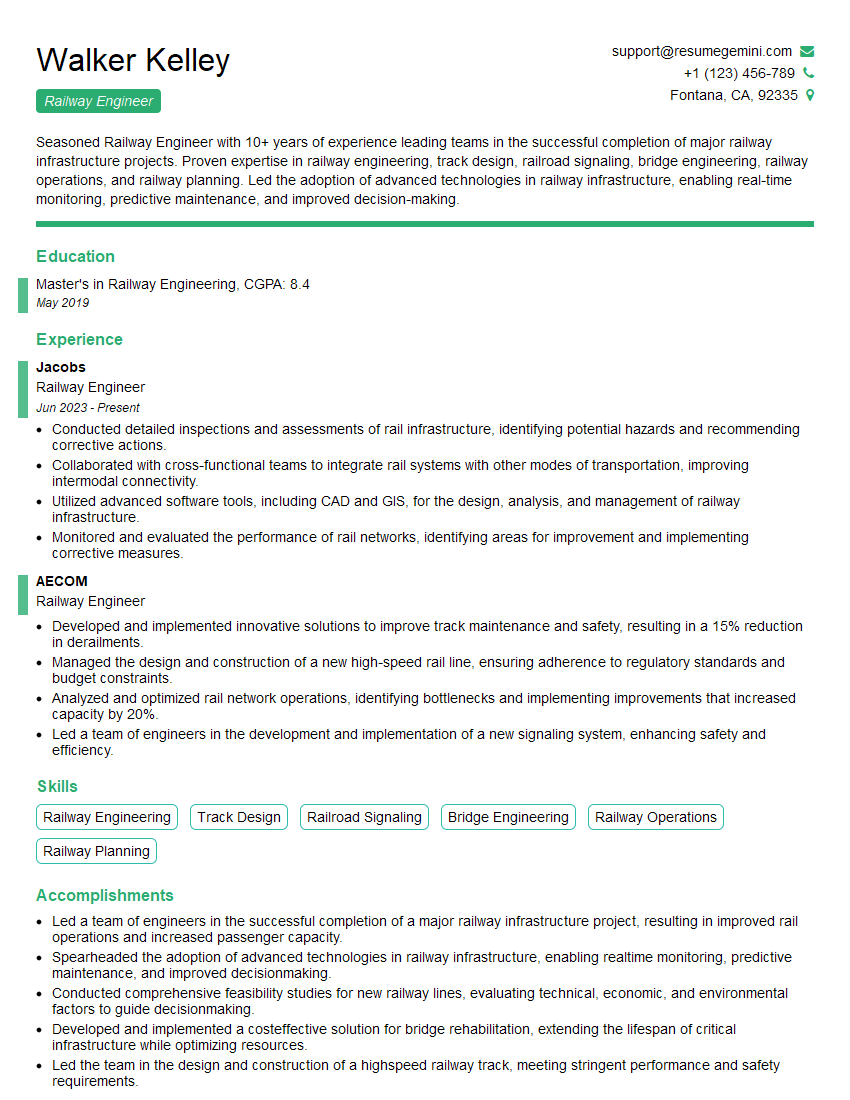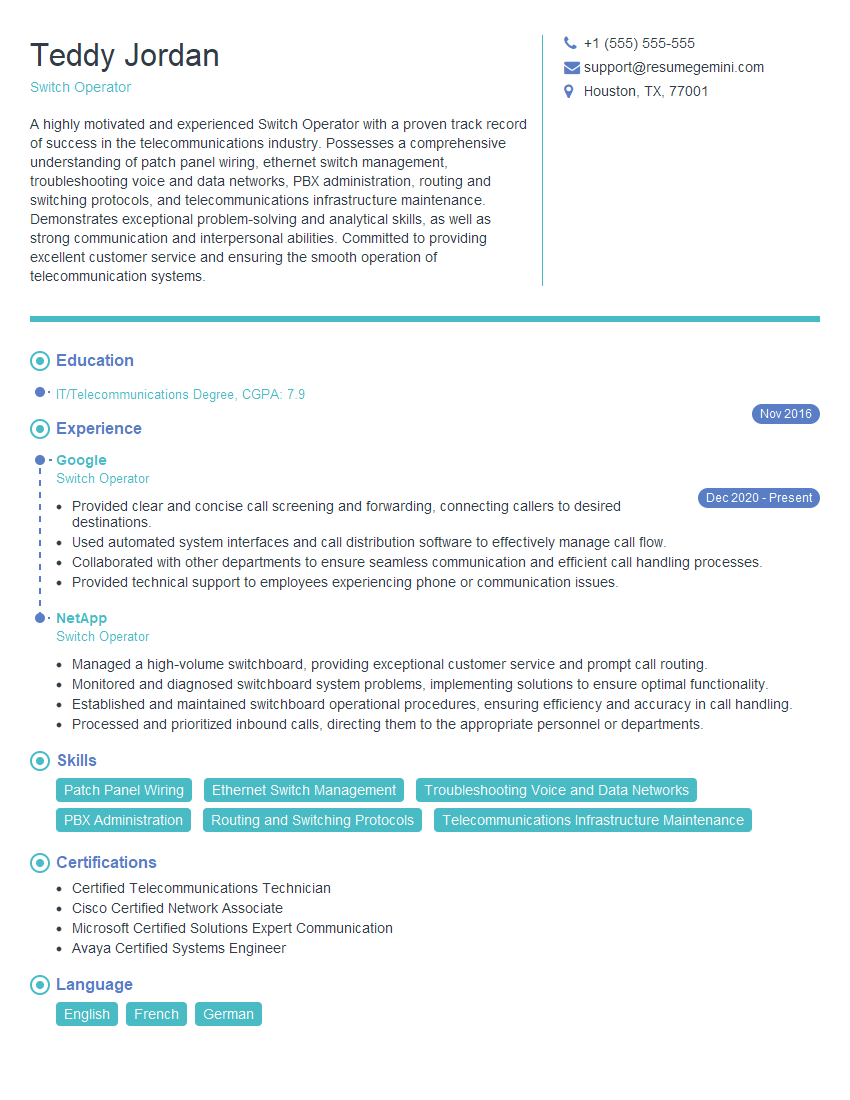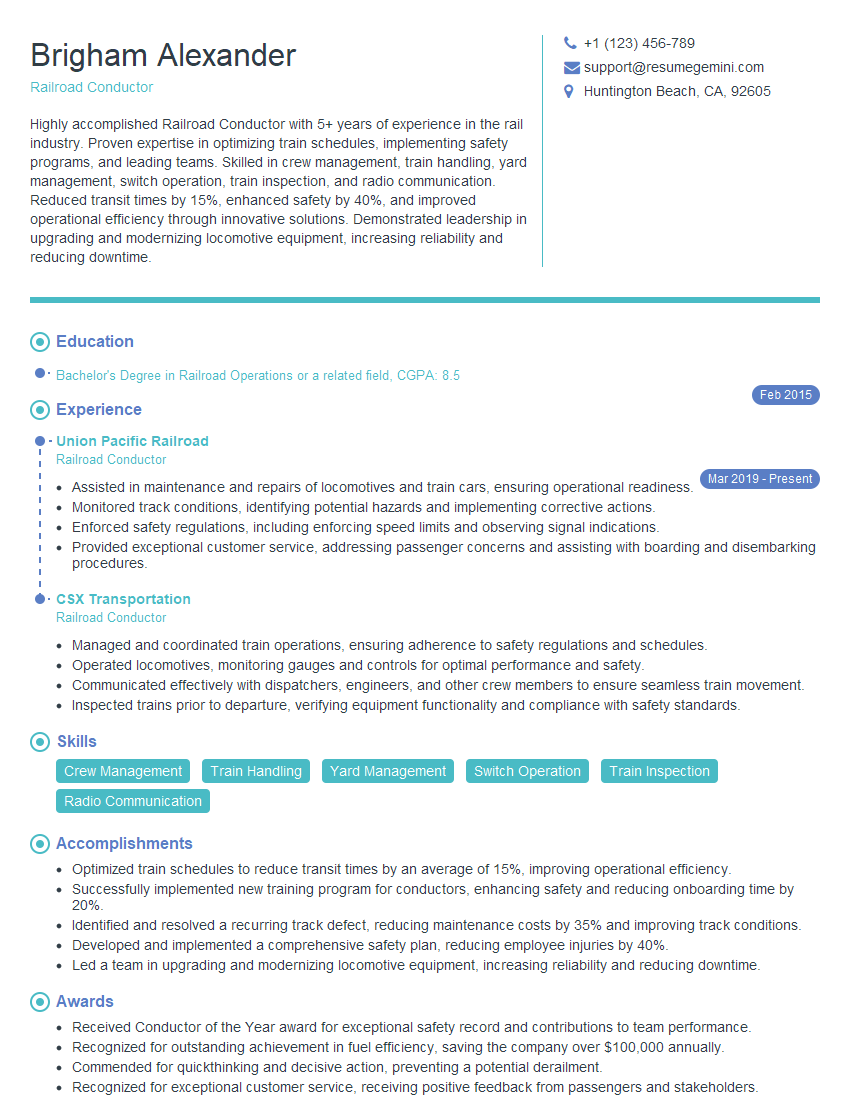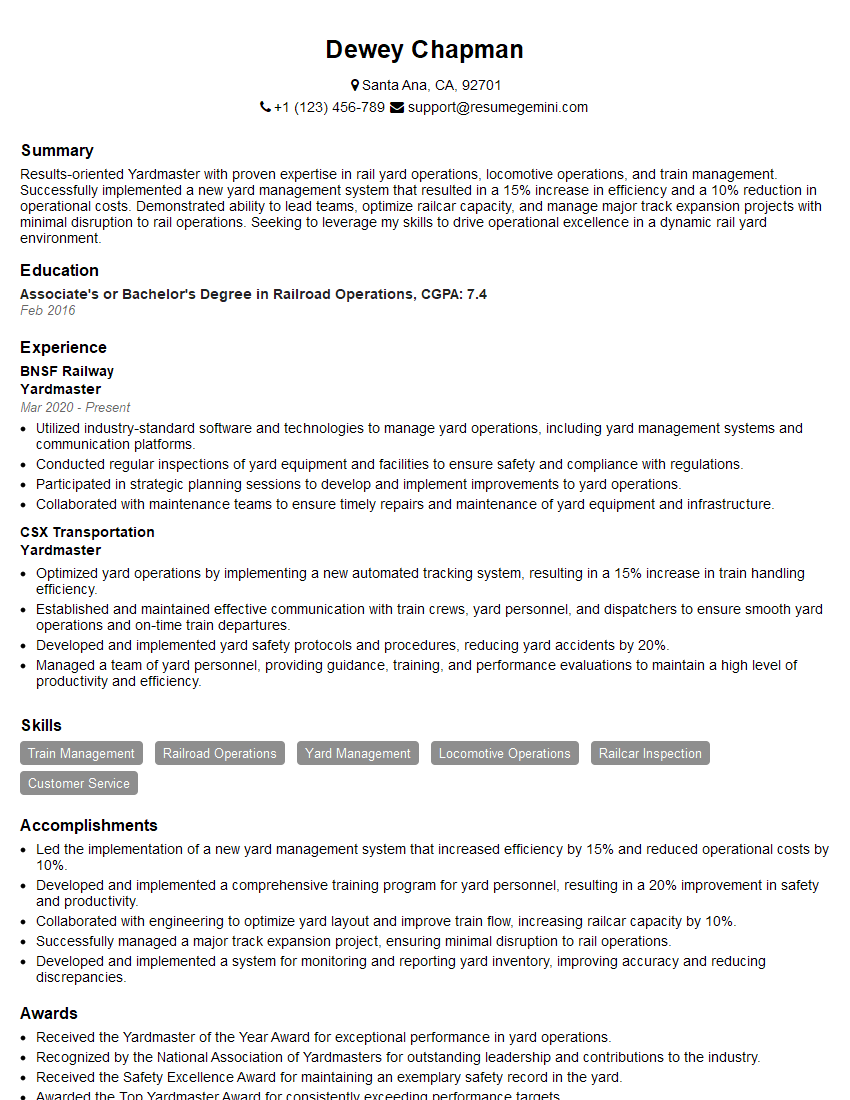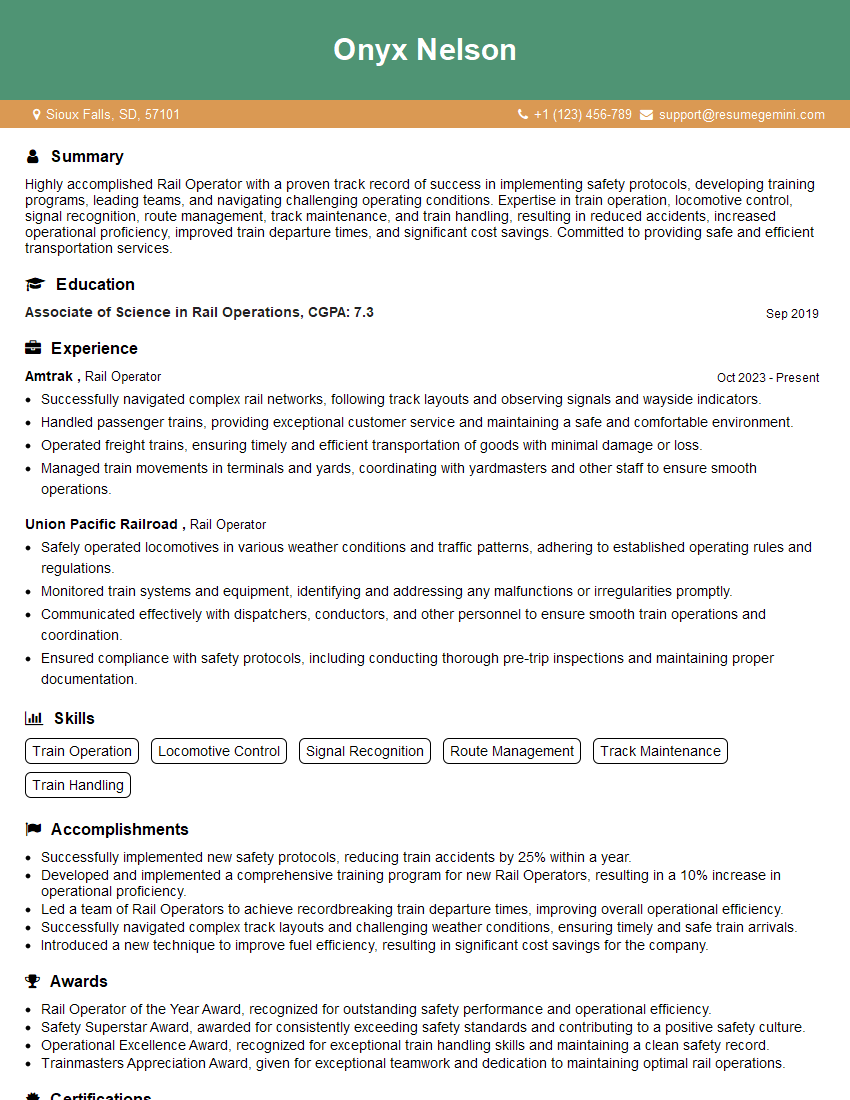Feeling uncertain about what to expect in your upcoming interview? We’ve got you covered! This blog highlights the most important Operate locomotives interview questions and provides actionable advice to help you stand out as the ideal candidate. Let’s pave the way for your success.
Questions Asked in Operate locomotives Interview
Q 1. Describe your experience operating different types of locomotives.
Throughout my career, I’ve operated a variety of locomotives, including diesel-electric units like the GE ES44AC and EMD SD70ACe, and older models such as the EMD GP38-2. Each type presents unique operational characteristics. For instance, the newer AC traction models (like the ES44AC) offer advanced electronics and control systems, resulting in smoother acceleration and braking, and improved fuel efficiency compared to the older DC models (like the GP38-2). I’ve also had experience with switching locomotives, smaller units designed for maneuvering cars within yards, requiring precise control and a different approach to handling the train’s momentum. My experience spans diverse operational contexts—from heavy freight hauling across varied terrains to switching operations in busy railyards, giving me a well-rounded understanding of locomotive performance under different demands.
Q 2. Explain the process of conducting a pre-trip inspection.
A pre-trip inspection is crucial for ensuring the safe operation of a locomotive. It’s a systematic process, and I typically follow a checklist. This includes:
- Visual Inspection: Checking for any visible damage to the locomotive’s body, undercarriage, and components like the couplers, air hoses, and brake systems. I look for leaks, cracks, or any signs of wear and tear.
- Fluid Levels: Verifying the levels of engine oil, coolant, fuel, and other essential fluids. Low levels can indicate a leak or other problem.
- Air System Check: Inspecting the air pressure gauges to ensure sufficient air pressure for braking and other pneumatic systems. A proper air pressure test is crucial for safety.
- Electrical Systems: Testing the headlights, marker lights, and other essential lighting systems. I also check the functionality of the control panel and communication systems.
- Brake System Test: Performing a thorough brake test to confirm the responsiveness and efficiency of the locomotive’s braking system. This involves several steps according to established procedures and is absolutely critical.
- Documentation: Recording all findings in the pre-trip inspection report, noting any issues or deficiencies. This provides a record for maintenance and addresses potential problems proactively.
Think of it like a thorough car check-up before a long journey – it’s preventative maintenance ensuring a safe and efficient trip.
Q 3. How do you handle unexpected mechanical issues while operating a locomotive?
Handling unexpected mechanical issues requires a calm and systematic approach. My first priority is always safety. This means:
- Assessing the Situation: Immediately determining the severity of the issue and its potential impact on safety. A loss of braking power, for example, is far more critical than a minor electrical fault.
- Communication: Contacting dispatch immediately to report the issue and request assistance. Clear and concise communication is essential in these situations.
- Emergency Procedures: Following the appropriate emergency procedures for the specific situation. This may involve bringing the train to a safe stop, activating warning signals, and securing the area.
- Troubleshooting (if safe): If it’s safe and within my capabilities, I might attempt basic troubleshooting, such as checking fuses or performing simple checks. But this is always secondary to safety; if unsure, I wait for professional assistance.
- Documentation: Thoroughly documenting the issue, including the time, location, nature of the problem, and actions taken. This documentation aids in the investigation and prevents future issues.
For example, if I experience a sudden loss of engine power, I would immediately activate the emergency brakes, contact dispatch, and explain the situation, making sure to pinpoint my location precisely.
Q 4. What safety procedures do you follow when coupling and uncoupling cars?
Coupling and uncoupling cars involves strict safety protocols. The primary concern is preventing damage to equipment and injuries to personnel. Before any coupling or uncoupling operation:
- Secure the Area: Ensuring the track is clear of any obstructions and that no personnel are in the danger zone.
- Brake Application: Applying hand brakes on the cars involved in the coupling or uncoupling process to prevent unwanted movement.
- Visual Inspection: Visually inspecting the couplers on both the locomotive and the cars to ensure they are in good working condition. I would check for any damage or misalignment.
- Communication: Clearly communicating with the ground crew (if present) before commencing any coupling or uncoupling maneuvers.
- Careful Maneuvering: Approaching slowly and carefully when coupling or uncoupling to avoid collisions or damage.
- Post-Coupling Check: After coupling, confirming that the couplers are securely engaged and the air hoses are correctly connected.
A failure to follow these procedures could result in derailments or serious accidents. I always prioritize safety above speed or efficiency.
Q 5. Describe your experience with train communication systems.
My experience with train communication systems includes both conventional radio systems and newer digital technologies. Conventional radio communication allows for direct voice communication with dispatchers and other train crews within a specific range. Digital systems like those employing cellular or satellite links offer broader coverage and enhanced capabilities, including data transmission and remote diagnostics. These systems are essential for coordinating train movements, receiving instructions, reporting incidents, and obtaining assistance. I am proficient in using both, understanding their limitations and capabilities. For instance, radio range can be affected by terrain and weather, so I am adept at adapting communication strategies to these factors. In scenarios with limited radio access, I would rely on pre-planned communication points or backup communication methods.
Q 6. How do you manage train speed and braking in various terrains and weather conditions?
Managing train speed and braking requires careful consideration of various factors, including terrain, weather conditions, and the train’s load. On uphill gradients, I’ll reduce speed to maintain adequate power and prevent stalling. Downhill gradients require careful use of the locomotive’s brakes to control speed and prevent runaway situations. In adverse weather conditions like rain, snow, or ice, braking distances are significantly extended, requiring even more cautious speed management and increased braking distances. I adjust my speed and braking strategies accordingly, constantly monitoring speed, track conditions, and weather forecasts. For example, on a steep downhill grade during icy conditions, I would engage dynamic braking to help slow the train and supplement the air brakes, creating extra margin for safety.
Q 7. Explain your understanding of train signaling systems and their importance.
Train signaling systems are crucial for maintaining safety and efficiency in railway operations. These systems use a variety of visual and audible signals (lights, signals, horns) to regulate train movements and prevent collisions. I am familiar with different types of signals, including color-light signals, absolute block signals, and Automatic Train Control (ATC) systems. Understanding and following these signals is paramount. For example, a red signal indicates a complete stop; yellow indicates proceed with caution, and green signals clear track ahead. ATC systems actively monitor train speed and location, automatically applying brakes if a train exceeds a set speed limit or enters a restricted area. My understanding of these systems allows me to operate safely and efficiently, even in challenging conditions.
Q 8. How do you ensure the safe handling of hazardous materials during transport?
Safe handling of hazardous materials during transport by rail is paramount. It involves meticulous adherence to regulations and strict protocols throughout the entire process, from loading to unloading. This begins with proper classification and labeling of the materials according to internationally recognized standards like the UN Dangerous Goods List. Each shipment requires detailed documentation specifying the nature of the goods, their hazard class, and emergency response procedures.
Before loading, I ensure the designated rail cars are appropriate for the specific hazardous material, considering factors like compatibility and containment. This often includes specialized tank cars or containers designed to withstand pressure, temperature fluctuations, and potential leaks. Securement is critical; we use appropriate restraints to prevent shifting during transit, minimizing the risk of spills or damage. Throughout the journey, I closely monitor the train’s performance, paying close attention to speed, temperature, and pressure gauges (where applicable), using this data to identify potential issues early on. In case of an emergency, I’m trained in emergency response procedures, knowing precisely what actions to take and how to contact relevant authorities. Regular inspections of the cargo and the car itself are crucial, both pre- and post-transport. For example, I would carefully check for leaks, damaged seals, or any signs of shifting cargo. Finally, meticulous record-keeping is vital, documenting every step of the process from origin to destination.
Q 9. Describe your experience with different types of train brakes (e.g., air brakes).
My experience encompasses various braking systems, predominantly air brakes, the industry standard. Air brakes operate using compressed air to activate brake shoes against the wheels. Understanding their components, including the brake cylinders, air reservoirs, and control valves, is crucial for safe operation. I’m proficient in applying and releasing brakes, managing brake pressures, and identifying malfunctions. I’ve worked with both automatic and independent air brake systems, recognizing the differences in their operation and maintenance requirements. For example, automatic brakes engage automatically when the train separates, preventing runaway cars. Independent brakes allow the engineer to control each car’s braking individually, useful for maneuvering in tight spaces or dealing with specific car issues. Beyond air brakes, I also possess some familiarity with other braking systems, such as electric regenerative braking used on some modern locomotives to recapture kinetic energy during deceleration.
Q 10. How do you maintain accurate train documentation and logs?
Maintaining accurate train documentation and logs is non-negotiable for safety and regulatory compliance. Every trip requires detailed records, starting with the pre-trip inspection report, documenting the locomotive’s condition, the train’s composition, and any potential issues. During operation, I meticulously record the train’s speed, location, stops, any delays, and any incidents, no matter how minor they seem. This includes noting fuel consumption, the status of various systems (e.g., air pressure, temperature readings), and any maintenance performed during the journey. Following the trip, I complete a post-trip inspection report, detailing any problems encountered and actions taken. These logs are crucial for maintenance scheduling, identifying recurring issues, and conducting accident investigations. Electronic logs are becoming increasingly prevalent, offering better organization and efficiency, but manual backups and paper copies are often kept for redundancy and compliance purposes. Data accuracy is my top priority—even a small error can have significant consequences.
Q 11. What are the common causes of locomotive malfunctions, and how do you troubleshoot them?
Locomotive malfunctions can stem from various sources, often related to the complex interplay of electrical, mechanical, and pneumatic systems. Common causes include issues with the engine itself (e.g., fuel injectors, piston problems), malfunctions in the air brake system (leaks, valve failures), electrical failures (wiring issues, faulty components), and problems with the cooling system.
Troubleshooting involves a systematic approach. I start by checking for obvious problems such as gauges showing abnormal readings, unusual sounds, or visible damage. I then consult the locomotive’s diagnostic systems, reading error codes and utilizing built-in troubleshooting guides. For example, a low air pressure reading might indicate a leak in the air brake system, requiring a detailed inspection of hoses and connections. If the problem is not readily apparent, I may resort to checking wiring diagrams and schematics to isolate the faulty component. Sometimes, a simple reset might resolve a minor glitch, while other situations may require more significant repairs, necessitating contacting a mechanic or seeking assistance from the maintenance crew. My experience has taught me to be methodical and thorough, documenting every step of the troubleshooting process to ensure effective resolution and prevent recurrences.
Q 12. Explain your understanding of railway regulations and safety standards.
My understanding of railway regulations and safety standards is extensive. I’m familiar with federal regulations (e.g., FRA in the US) and any relevant state or company-specific rules. This includes thorough knowledge of safety procedures, emergency response plans, signal recognition, and operating rules, including speed restrictions, track conditions, and switch operation. I understand the importance of following signal indications, respecting track warrants and work zones, and maintaining communication with dispatchers and other crew members. I’m well-versed in the use of safety devices like train-borne safety systems (e.g., positive train control) and know how to react in emergency situations. For instance, understanding and acting correctly upon a signal indicating a speed restriction is crucial for preventing accidents. This involves slowing the train safely and reporting the situation to the dispatcher.
Q 13. How do you prioritize safety when working in a high-pressure environment?
Prioritizing safety in a high-pressure environment requires a proactive and disciplined approach. It’s not just about reacting to immediate threats but about anticipating potential problems and implementing preventative measures. This starts with adhering strictly to all safety protocols, double-checking equipment, and ensuring I am well-rested and focused before operating the train. I maintain open communication with my crew, fostering a culture of mutual respect and safety awareness. I never hesitate to report potential hazards or concerns, no matter how small, and always consider the ‘what-if’ scenarios. For example, if I anticipate a potential delay, I proactively inform the dispatcher and adjust my speed accordingly to reduce the risk of collisions. If a piece of equipment seems suspicious, I’ll flag it for inspection before continuing operations rather than risking a breakdown further down the line. Essentially, it’s about creating a safety-first mindset, not just for myself, but for my crew, passengers, and everyone near the tracks.
Q 14. Describe your experience working with a train crew.
Working with a train crew involves close teamwork and effective communication. The engineer (me), conductor, and any other crew members need to be a well-coordinated unit. Effective communication is central; we use standardized procedures and communication channels to exchange information, relaying signals, sharing updates, and addressing potential problems. This includes clear reporting of train status, handling instructions, and any potential hazards. The conductor is responsible for handling paperwork and overseeing the train’s physical aspects, ensuring cars are properly coupled and secured, and also managing the tasks related to the freight load. I rely on the conductor’s expertise in managing train specifics, while they rely on my understanding of the locomotive and safe operating procedures. This collaboration not only ensures smooth operation but also enhances safety. For example, if the conductor notices a problem with a car, they will immediately inform me, and we’ll work together to decide on the appropriate course of action. Regular briefings before and during trips are key to maintaining a strong and collaborative relationship within the team, ensuring everyone is fully informed and coordinated.
Q 15. How do you handle stressful situations, such as delays or emergencies?
Stressful situations, like unexpected delays or emergencies, are part of the job. My approach is systematic and prioritizes safety above all else. First, I assess the situation calmly, identifying the core problem. For example, if a signal malfunction causes a delay, I’ll immediately contact the dispatcher, relaying the situation accurately and seeking guidance. If it’s an emergency, such as a mechanical failure, I’ll follow established emergency procedures, securing the train and ensuring passenger safety. My experience includes handling situations like sudden braking due to track obstructions, requiring quick thinking to avoid derailment. In each instance, clear communication, quick assessment, and adherence to safety protocols are key. I also practice mindfulness techniques to manage my stress levels and maintain focus during challenging times.
For example, during a recent incident involving a broken rail, I calmly guided passengers through the evacuation process, simultaneously reporting to the dispatcher and coordinating with emergency services.
Career Expert Tips:
- Ace those interviews! Prepare effectively by reviewing the Top 50 Most Common Interview Questions on ResumeGemini.
- Navigate your job search with confidence! Explore a wide range of Career Tips on ResumeGemini. Learn about common challenges and recommendations to overcome them.
- Craft the perfect resume! Master the Art of Resume Writing with ResumeGemini’s guide. Showcase your unique qualifications and achievements effectively.
- Don’t miss out on holiday savings! Build your dream resume with ResumeGemini’s ATS optimized templates.
Q 16. What is your experience with fuel efficiency and optimizing locomotive performance?
Fuel efficiency is crucial for both economic and environmental reasons. My experience encompasses various techniques for optimizing locomotive performance and minimizing fuel consumption. This includes maintaining consistent speeds, avoiding unnecessary acceleration and braking, and utilizing the locomotive’s power management systems effectively. I’m adept at recognizing and addressing issues that impact fuel efficiency, such as under-inflated wheels or excessive idling. Furthermore, I regularly review data from the locomotive’s onboard computer to identify areas for improvement and track progress.
For instance, I learned that smoother acceleration and deceleration, achieved by anticipating upcoming gradients and speed restrictions, resulted in a noticeable decrease in fuel consumption in my previous role. This not only saved the company money but also reduced our carbon footprint.
Q 17. Explain your understanding of locomotive maintenance schedules and procedures.
Locomotive maintenance is critical for safety and operational reliability. My understanding encompasses preventative maintenance schedules, which involve regular inspections of key components like brakes, wheels, engines, and electrical systems. I’m familiar with the specific procedures for each inspection, including visual checks, functional tests, and lubrication. I also understand the importance of adhering to manufacturer’s recommendations and maintaining accurate records of all maintenance activities. This involves documenting all repairs, replacements, and findings to ensure traceability and compliance. Corrective maintenance is also a key aspect, involving the prompt diagnosis and repair of any malfunctions or failures identified during inspections or operation.
For example, I’m proficient in performing daily pre-trip inspections, checking everything from fluid levels to brake functionality, which helps prevent more serious problems later.
Q 18. How do you communicate effectively with dispatchers and other train crews?
Effective communication is paramount in railway operations. I utilize standard railway communication protocols, such as radio communication, to interact with dispatchers and other train crews. This involves clear and concise reporting, using standardized terminology to avoid miscommunication. I always confirm messages to ensure understanding, and I’m skilled at adapting my communication style to suit different situations and individuals. For example, in emergency situations, brevity and clarity are essential, while routine updates may require more detail. Maintaining a respectful and professional demeanor is equally important in fostering a collaborative working environment.
I’ve developed a system for using checklists during communication to ensure nothing is missed, particularly in high-pressure scenarios.
Q 19. Describe your experience with different types of railway tracks and their impact on train operation.
Different types of railway tracks significantly impact train operation. I’m familiar with various track gauges (the distance between the rails), track conditions (e.g., curves, gradients, and track quality), and the impact on train speed, traction, and stability. For instance, tighter curves require reduced speeds to prevent derailment, while steeper gradients necessitate the use of more powerful locomotives or assisted braking. The condition of the tracks – such as the presence of irregularities or damaged sections – can also affect train operation, requiring slower speeds or careful maneuvering. My experience includes operating on tracks with varying gradients and curvatures, adapting my driving technique accordingly to ensure safe and efficient operation.
I’ve experienced firsthand how different track types (e.g., welded rail vs. jointed rail) affect the ride smoothness and noise levels. This influences both passenger comfort and equipment longevity.
Q 20. How do you ensure compliance with environmental regulations while operating a locomotive?
Environmental compliance is a high priority. I’m aware of and strictly adhere to all relevant environmental regulations related to locomotive operation, including emission control standards and waste disposal procedures. This involves operating the locomotive efficiently to minimize fuel consumption and emissions. I am also familiar with the regulations concerning noise pollution and taking steps to mitigate noise levels, where possible. Moreover, I’m trained to handle any spills or leaks of hazardous materials according to established protocols, ensuring prompt reporting and cleanup. I am also knowledgeable of the regulations concerning the disposal of used oils and other waste materials and always adhere to the proper procedures.
Regular maintenance, such as checking for leaks or faulty equipment, is part of ensuring environmental compliance.
Q 21. What is your experience with using onboard computer systems in locomotives?
Modern locomotives are equipped with sophisticated onboard computer systems that monitor various parameters, such as speed, engine performance, brake system status, and fuel consumption. I’m proficient in using these systems to access real-time data and diagnostics, which aids in preventing malfunctions and ensuring efficient operation. This includes interpreting diagnostic trouble codes (DTCs) and taking appropriate actions based on the displayed information. The systems also provide valuable information for post-trip analysis, assisting in identifying areas for improved fuel efficiency or performance.
For example, the onboard computer on my previous locomotive alerted me to a developing engine issue, allowing for a preventative maintenance stop before it escalated into a major problem.
Q 22. Describe a time you had to make a quick decision to ensure safety while operating a train.
During a heavy rainstorm, I was operating a freight train through a mountainous region. Visibility was significantly reduced due to the downpour and fog. As I approached a sharp curve, I noticed a rockslide partially blocking the track ahead, something not indicated on my current track information. Instead of blindly proceeding, I immediately initiated an emergency braking procedure. This quick decision prevented a potential derailment and subsequent catastrophe. My immediate actions included activating the emergency brakes, contacting dispatch to report the obstruction and request assistance, and preparing for the potential need for manual track inspection once the train had come to a complete stop. The swift response prevented a potentially disastrous situation. This situation highlighted the importance of constant vigilance and proactive safety measures, even when operating under challenging weather conditions.
Q 23. How do you stay updated on changes in railway technology and safety regulations?
Staying current in the railway industry is crucial for safety and efficiency. I utilize several methods to stay abreast of changes. Firstly, I actively participate in mandatory safety training courses provided by the railway company. These sessions cover updates to regulations, new technologies, and best practices in operation. Secondly, I regularly consult industry publications like Railway Age and Railway Gazette International, which provide in-depth analysis of technological advancements and safety improvements. Thirdly, I’m a member of professional organizations like the Association of American Railroads (AAR), which offer access to webinars, conferences, and networking opportunities to discuss emerging trends and concerns within the field. Finally, I maintain a network of colleagues and mentors within the industry, exchanging information and experiences to share insights and best practices.
Q 24. Explain your understanding of the different types of locomotive engines.
Locomotive engines are categorized primarily by their power source and transmission methods. The most common types include:
- Diesel-Electric Locomotives: These are the workhorses of modern freight and passenger rail. They use a diesel engine to generate electricity, which then powers traction motors that drive the wheels. This allows for efficient power distribution and control.
- Electric Locomotives: These draw power from an external source, typically an overhead catenary system (overhead wires) or a third rail. They are highly efficient and often used on high-speed rail lines and electrified sections of track. They require substantial infrastructure investment for the power supply system.
- Gas Turbine-Electric Locomotives: Less common now, but still used in some specialized applications, these use a gas turbine to generate electricity, which then powers traction motors. They offer high horsepower but lower efficiency compared to diesel-electric locomotives.
Each type has its advantages and disadvantages concerning fuel efficiency, power output, maintenance requirements, and environmental impact. The choice of locomotive engine depends heavily on the specific operational requirements and infrastructure available.
Q 25. How do you calculate the weight and length of your train to ensure safe operation?
Accurately calculating train weight and length is paramount for safe operation. Before departing, I consult the train consist, a detailed list of all cars and their specifications, including weight and length. This information is usually provided electronically. The total weight is crucial for determining the stress on tracks, bridges, and other infrastructure, ensuring I do not exceed safe weight limits for a particular route. The total length is vital for determining safe stopping distances, particularly on curves and in areas with limited visibility. We use sophisticated onboard systems and communication with dispatchers to monitor and manage weight and length in real-time. If the weight or length exceeds the permissible limits for a specific track section, adjustments must be made, potentially requiring the train to be split or certain cars to be detached, with communication and coordination with dispatchers being essential.
Q 26. Describe your experience with operating locomotives in different weather conditions (e.g., snow, rain, fog).
Operating locomotives in varying weather conditions requires adaptability and adherence to stringent safety protocols. In snowy conditions, reduced traction is a primary concern. I must reduce speed significantly, maintain increased following distances, and be extra vigilant for potential ice buildup on the tracks. In rain, reduced visibility and potential for track washout necessitates similar precautions. Fog necessitates further speed reductions and the increased use of horns and other warning signals. Extreme cold and heat also affect equipment performance and require extra attention to mechanical systems. My experience has taught me to always anticipate challenging weather conditions and adapt my driving style and communication with dispatch to prioritize safety. Preparation, proactive communication, and adherence to established safety procedures are paramount in mitigating risks associated with various weather patterns.
Q 27. What are your strategies for preventing derailments and other accidents?
Preventing derailments and accidents involves a multifaceted approach, focusing on both proactive measures and reactive responses. Proactive strategies include:
- Regular inspections: Thorough pre-trip inspections of the locomotive and train cars are mandatory, checking for any mechanical issues, brake functionality, and wheel alignment.
- Adherence to speed limits: Strictly adhering to posted speed limits, especially on curves and in areas with reduced visibility.
- Proper braking techniques: Utilizing appropriate braking procedures, anticipating potential challenges ahead and adjusting speeds accordingly.
- Communication and coordination: Effective communication with dispatchers, track maintenance personnel, and other train operators to maintain awareness of track conditions and potential hazards.
Reactive strategies include:
- Emergency braking procedures: Knowing and implementing emergency braking procedures promptly if a hazard is encountered.
- Effective reporting: Reporting any potential safety issues or irregularities immediately to relevant authorities.
- Following safety protocols: Strictly adhering to all safety regulations and guidelines established by the railway company and regulatory bodies.
A combination of proactive diligence and reactive preparedness significantly contributes to a safer operating environment.
Key Topics to Learn for Operate Locomotives Interview
- Locomotive Systems: Understanding the fundamental components of a locomotive, including the engine, transmission, braking systems, and electrical systems. This includes knowing the differences between various locomotive types and their functionalities.
- Operational Procedures: Mastering safe and efficient operating procedures, such as starting, stopping, coupling, and uncoupling locomotives. This includes adhering to safety regulations and protocols, and understanding the importance of pre-trip inspections.
- Track and Signaling Systems: Knowledge of track configurations, signals, and communication systems is crucial for safe and efficient operation. This includes understanding the meaning of various signals and how to react to unexpected situations.
- Safety Regulations and Compliance: Demonstrating a thorough understanding of all relevant safety regulations, including those related to train handling, emergency procedures, and hazardous materials. This also encompasses familiarity with reporting procedures and documentation.
- Troubleshooting and Maintenance: Basic understanding of common locomotive problems, their causes, and simple troubleshooting steps. This includes knowing when to escalate issues to maintenance personnel.
- Communication and Teamwork: Effective communication skills are essential for coordinating with dispatchers, crew members, and maintenance personnel. This includes clear and concise communication in potentially stressful situations.
- Load Management and Train Dynamics: Understanding how to manage train loads, considering factors like weight, grade, and speed to ensure safe and efficient operation. This includes knowledge of train dynamics and the impact of various factors on train performance.
Next Steps
Mastering the operation of locomotives opens doors to a rewarding and stable career with excellent growth potential. As you advance, you can specialize in areas like maintenance, dispatching, or management. To secure your dream job, a strong resume is essential. Creating an ATS-friendly resume is critical to getting your application noticed by employers. ResumeGemini can help you build a professional, impactful resume that highlights your skills and experience. Examples of resumes tailored to the Operate Locomotives field are available within ResumeGemini to help guide you. Invest time in crafting a compelling resume – it’s your first impression with potential employers.
Explore more articles
Users Rating of Our Blogs
Share Your Experience
We value your feedback! Please rate our content and share your thoughts (optional).
What Readers Say About Our Blog
Hi, I’m Jay, we have a few potential clients that are interested in your services, thought you might be a good fit. I’d love to talk about the details, when do you have time to talk?
Best,
Jay
Founder | CEO

